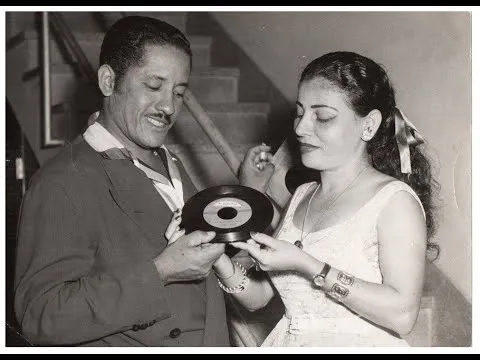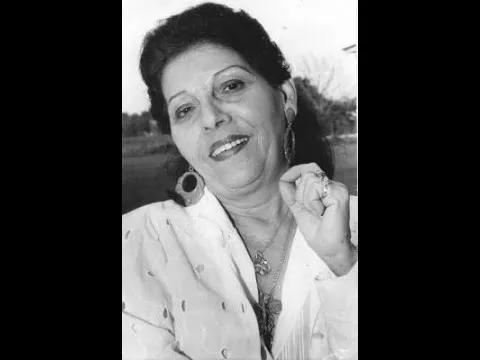
Amigos vengo nuevamente a esta comunidad @music para hablarle de otra estrella en la constelación de la música cubana: Celina González, una de las máximas exponentes del Punto Cubano.
Según la fuente Celina nació en Jovellanos, Matanzas en 1922. Vivió parte de su vida en Santiago de Cuba, luego en La Habana. En su hogar eran frecuentes los guateques, esos festejos o canturías en los campos cubanos. Su padre también cantaba y sus hermanos tocaban laúd y tres.
Celina hizo dúo con su esposo Reutilio, luego continuó su carrera en solitario y en la ultima etapa se hacia acompañar por su hijo Reutilio en un repertorio reconocido en muchas partes del mundo.
El Punto Cubano fue su estilo. La mayoría de los cubanos tarareamos alguna vez sus canciones por sus rítmos, las décimas, la improvisación, las tonadas. Estos elementos hicieron una estructura que se convirtió en un género de incalculable riqueza cultural. En Yo soy el punto cubano Se escucha el tres, el güiro y la marimba, acompañando la prodigiosa voz de Celina González con frases muy cubanas..
Celina González y el Punto Cubano son como parte del tesoro musical de Cuba. En sus letras evocan el paisaje, las aves como el gallo, el sinsonte, la paloma; las flores, el amor, el desamor; los orishas, todo.
La vida artística de Celina González fue prolifera, desde niña recuerdo a mis padres pegados a la radio para escuchar los programas campesinos donde eran frecuentes nombres como Justo Vega, Adolfo Alfonso, El Gilguero de Cienfuegos, El Indio Naborí, Ramón Véloz, Coralia y Celina González. Nombres que luego dieron vida a las tradiciones desde la televisión en el programa Palmas y Cañas que aún existe aunque ya no tiene el mismo atractivo.
En este número que les presento, como en otros, se adaptaron las estructuras poéticas de la décima, la melodía junto al laúd, el tres, la guitarra, las claves, marimba y el güiro para cantar a Babalú Ayé
Esta artista demostró gracia y elegancia en el escenario, su vestuario exhibía los colores rojo, blanco y azul y se adornaba el cabello con una flor silvestre. Su estilo y timbre es único en la interpretación del Punto Cubano, género que representó desde su llegada a la Captital. En la definición de este género tuvo incidencia el importante músico cubano Ñico Saquito.
Actuó junto a Benny Moré, Celia Cruz y otros grandes de la musica cubana. Este género fue declarado Patrimonio Cultural Inmaterial de la Humanidad en 2017, Celina González no pudo ver tal nombramiento, murió en el 2015. Esta sonoridad es un símbolo de la cubanidad y sobre todo de la cultura campesina y en la Cuba después de 1959 se convirtió en el calco del sistema social.
Celina se caracterizó por el amor a las deidades afrocubanas y de su garganta brotaron hermosas canciones en tributo a los orishas. Que viva Shangó es una de ellas.
En Cuba se han olvidado muchos exponentes de la música y el Punto Cubano no ostenta el mismo brillo por repetitivo y falta de esencia. Pero se mantiene vivo gracias a la labor de músicos, poetas, investigadores y comunidades que lo practican y lo transmiten.
Actualmente hay una oleada de niños que quizas adapten a nuevos contextos esta herencia musical y lo pongan, como Celina González, en lo más alto de la gloria universal.
Esta publicación ha sido escrita por mí y las imágenes utilizada están referenciadasGracias por visitar mi blog, soy Critica de arte y Investigadora Social, amante de la cocina. Te invito a conocer más de mi, de mi país y de lo que escribo

English
Song of the Jungle, Celina González and the Cuban Point 🇨🇺🎶

Friends, I'm back on this @music community to tell you about another star in the constellation of Cuban music: Celina González, one of the greatest exponents of Punto Cubano.
According to the source, Celina was born in Jovellanos, Matanzas, in 1922. She lived part of her life in Santiago de Cuba, then in Havana. Guateques, those celebrations or sing-alongs in the Cuban countryside, were common in her home. Her father also sang, and her brothers played the lute and tres. Celina formed a duo with her husband Reutilio, then continued her solo career, and in her later years, she was accompanied by her son Reutilio in a repertoire recognized throughout the world.
Cuban Punto was his style. Most Cubans have hummed his songs at some point, for their rhythms, the décima, the improvisation, the tonada. These elements formed a structure that also became a genre of incalculable cultural richness. In Yo soy el punto cubano you can hear the tres, the güiro, and the marimba, accompanying Celina González's prodigious voice with very Cuban phrases.
Celina González and Punto Cubano are like part of Cuba's musical treasure. Their lyrics evoke the landscape; birds like the rooster, the mockingbird, and the dove; flowers; love, heartbreak; the orishas—everything.
Celina González's artistic life was prolific. Since she was a child, I remember my parents glued to the radio listening to country programs where names like Justo Vega, Adolfo Alfonso, El Gilguero de Cienfuegos, El Indio Naborí, Ramón Véloz, Coralia, and Celina Gonzalez were frequent.
These names later brought traditions to life on television in the program Palmas y Cañas, which still exists today, although it no longer has the same appeal. In this issue that I present to you, as in others, the poetic structures of the tenth, the melody together with the lute, the tres, the guitar, the claves, marimba and the güiro were adapted to sing to Babalú Ayé
This artist displayed grace and elegance on stage. Her wardrobe displayed the colors red, white, and blue, and she adorned her hair with a wildflower. Her style and timbre are unique in her interpretation of Punto Cubano, a genre she has represented since her arrival in the capital. The important Cuban musician Ñico Saquito was instrumental in defining this genre. She performed alongside Benny Moré, Celia Cruz, and other greats of Cuban music.
This genre was declared Intangible Cultural Heritage of Humanity in 2017. Celina González was unable to live to see this recognition; she died in 2015. This sound is a symbol of Cuban identity and, above all, of peasant culture, and in Cuba after 1959, it became a reflection of the social system. Celina was characterized by her love for Afro-Cuban deities, and beautiful songs in tribute to the orishas flowed from her voice. Long live Shango is one of them.
In Cuba, many of the glories of music have been forgotten, and Cuban Punto no longer holds the same brilliance due to repetitiveness and a lack of essence. But it remains alive thanks to the work of musicians, poets, researchers, and communities that practice and transmit it.
There is currently a wave of children who may adapt this musical heritage to new contexts and, like Celina González, place it at the top of universal glory.
This post was written by me, and the images used are referenced.Thank you for visiting my blog. I am an art critic and social researcher, a lover of cooking. I invite you to learn more about me, my country, and what I write.



